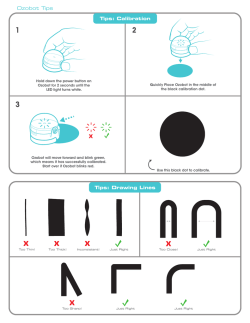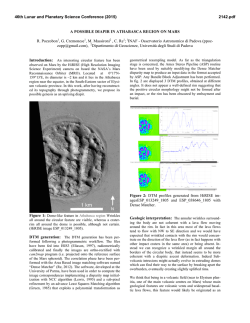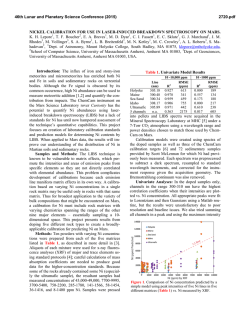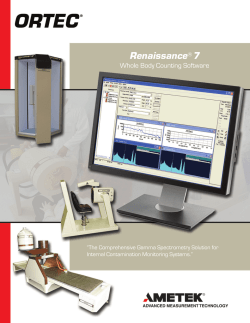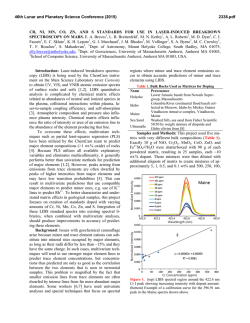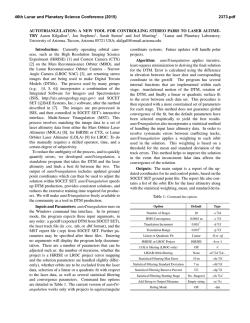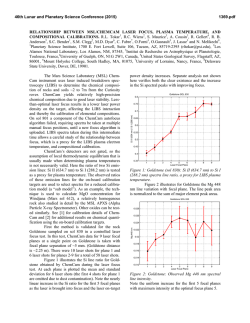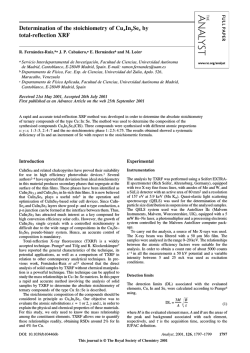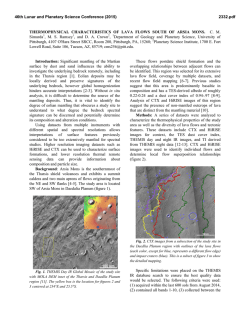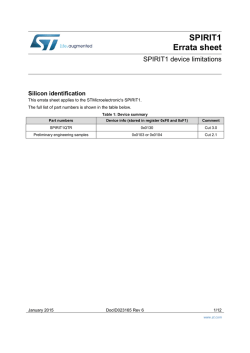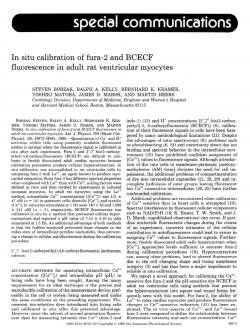
MRO/HIRISE RADIOMETRIC CALIBRATION UPDATE. M. P. Milazzo
46th Lunar and Planetary Science Conference (2015) 1498.pdf MRO/H I RISE R ADIOMETRIC C ALIBRATION U PDATE . M. P. Milazzo1, , K. Herkenhoff1 , K. Becker1 , P. Russell2 , A. Delamere3 , A. S. McEwen4 ; 1 Astrogeology Science Center, U.S. Geological Survey, 2 Smithsonian Institute, 3 Delamere Support Services, 4 University of Arizona; ([email protected]) Introduction: The High Resolution Imaging Science Experiment (HiRISE) onboard the Mars Reconnaissance Orbiter (MRO) [1] has been observing Mars since 2006 and has acquired more than 38,000 observations of the martian surface. The HiRISE instrument is a pushbroom imaging system made up of fourteen linear, two-channel, Charge Coupled Devices (CCDs). Ten 2048-pixelwide CCDs with a broadband red filter (RED CCDs) are laid sideby-side with an overlap of 48-pixels on each side for a total of 20,264 pixels. In front of and behind the RED CCDs, as viewed in the along-track direction, are four more CCDs, two each with a blue-green (BG CCDs) and near-IR (IR CCDs) filter respectively (Figure 1). The HiRISE instrument thus consists of 28 separate channels calibrated independently. Radiometric calibration is a critical step in image analysis; without it, quantitative comparisons of colors and brightnesses between observations and between instruments would be impossible. To-date, because of a lack of accurate radiometric calibration, most martian studies using HiRISE images have been morphological in nature. Once radiometric calibration has been finalized, inter- and intra-instrument brightness, color, color-ratio, and spectral studies will be possible. For example, quantitative comparisons between the high-spectral-resolution imaging spectrometer, CRISM (Compact Reconnaissance Imaging Spectrometer for Mars) and the highspatial-resolution HiRISE will be possible [2]. The two channels on a given CCD are commanded with identical imaging parameters but contain separate electronics, so require independent calibration parameters. The two main imaging parameters that affect radiometric calibration are TDI (Time Delay and Integration) and binning. TDI is a method for increasing signal by capturing up to 128 lines of data over a single ground point; TDI modes of 8, 16, 32, 64, and 128 are possible. Each CCD may be binned over 2x2, 4x4, or 8x8 blocks of pixels, increasing signal to noise at the expense of spatial resolution. The calibration routines operate on each of these TDI, BIN combinations for each of the 28 CCD channels. A schematic of a HiRISE channel’s calibration data is shown in Fig 2: Figure 1: Schematic of the HiRISE Focal Plane Array. The IR CCDs observe the ground first, then the RED CCDs, and finally the BG CCDs. * Pre-Observation Lines: For each sample, data are acquired immediately before the image observation lines from three distinct calibration sources. – Reverse Clock Pixels: 20 lines of offset signal. – Masked Pixels: charge generated in the active area of the CCD is transferred, one line at a time, through 20 lines of pixels behind a mask. – Ramp Lines: Number of lines equally to TDI ÷ BIN. These include initial signal from the reverse and forward clocking through the CCD. For a flat target and no dark current or offset, the last Ramp line should have twice the signal of the image line immediately following. * Pre-Image Samples: The Buffer Pixels comprise 12 samples read out of the serial register before each image line. These Buffer Pixels only contain serial dark current and offset. * Post-Image Samples: The Dark Pixels comprise the 16 pixels at the end of each line of the CCD. These pixels were masked from exposure by metallization deposited onto the CCD and should only contain serial and parallel dark current and offset signal. Radiometric Calibration: Below, we describe the radiometric calibration requirements and what has been accomplished to date to meet those requirements. Updated analyses will be presented at the conference in March. Scattered Light: The HiRISE baffle system was designed for the minimization of scattered light from the disk of Mars with a goal of less than 2% of the nominal signal. HiRISE acquired observations of Phobos for analysis of scattered light. Scattered light was undetectable in the well-planned images, and from those analyses we conclude that scattered light contributes at most 0.22% and more probably 0.1% or less. Figure 2: Schematic of the structure of the raw HiRISE image channel as delivered to the PDS. 46th Lunar and Planetary Science Conference (2015) Relative (Pixel-to-Pixel) Calibration: The requirement for HiRISE relative calibration was that calibrated pixels would exhibit better than 1% pixel-to-pixel accuracy for 99.5% of the pixels within each CCD and across the FOV when using 128 lines of TDI. Relative accuracy of 1% is required over a 10-second image exposure. Flat-field calibration data were acquired in the laboratory before launch and at Mars by yawing the spacecraft 90-degrees to the direction of travel. These data indicate a relative pixel-to-pixel accuracy of less than 0.5%. A more accurate number, with full error analysis will be presented at the conference. A 10-second exposure of an average brightness surface will produce an observation of approximately 100,000 lines, assuming 100 µs line exposure time which is typical of science imaging. Night-side calibration images were generally taken with fewer lines for a number of operational reasons. On a 2.5-second exposure, electronics-induced noise drifts by approximately 1.7% (∼20-DN), but this effect is measurable using the Buffer Pixels. Our accuracy in correcting the drift for a night-side, dark image is approximately 1.4% (∼20-DN) over 2.5-seconds, though the largest drift occurs during the first 1-second (10,000 lines) and there appears to be minimal drift after about 50,000 lines. The absolute value of this error in measuring the drift is independent of the target (because it is electronics noise rather than photon-generated), and is approximately 20 DN. For a well-exposed science image with average DN of 4000 or more, the error is 0.5% or better. The analysis of the relative calibration across the full observation FOV will be presented at the conference. At this time, we are confident that the Reduced Data Records (RDRs) released to the PDS have relative accuracy on a per-channel-basis of 1% or better for a well-exposed surface image with TDI=128 and better than 2% across the FOV. Absolute Calibration: The absolute calibration accuracy requirement was 20% or better in all channels using 64 TDI lines. Because HiRISE is a linescan/pushbroom imaging system, standard stellar calibration targets are not as useful for absolute radiometry as they are for framing cameras. The special calibration sequence we performed with Jupiter is phase-, time-, and thus modeldependent. Special calibration sequences with the Moon and Earth have proven difficult to analyze due to imaging geometry and because the observations taken during cruise have few comparable observations during science operations. The martian moons have been observed by too few independent instruments for high quality comparisons. We have been forced to compare HiRISE images of the martian surface with much lower-resolution imaging systems such as Hubble, CRISM, and MARCI. Our absolute calibration is within 20% of the calibration of those instruments, but we have not yet verified the calibration against well-established standard calibration targets. Spectral Response: As a goal, the relative spectral response of each pixel over the entire FOV should be 5% accuracy from 400 1498.pdf to 1100-nm in steps of 50-nm. Calibration of the spectral response is similarly complicated by the lack of standard calibration targets. Based on laboratory measurements before launch, the relative spectral response of the three HiRISE filters is 4%. Signal to Noise Ratio: The requirement for signal to noise (SNR) is 100:1 for RED CCD data acquired at 300-km altitude when imaging the martian surface with average albedo of 0.25, 70degree incidence angle, and when Mars is at its average distance from the sun (1.5 AU) with imaging parameters of 128 TDI and BIN 1. For the same situation, the BG CCDs (except with an average albedo of 0.1) are required to have SNR of at least 25:1 and the IR CCDs 50:1. The HiRISE SNR is generally much higher (200:1 or better for the RED CCDs and 50:1 or better for the IR and BG CCDs). Conclusions: Results are summarized in Table 1. Software: HiRISE Experimental Data Records (EDRs) are processed through the HiRISE Operations Center (HiROC) via a series of custom processing steps [3]. The key processing step is the U.S. Geological Survey Astrogeology Science Center’s ISIS3 application hical [4]. hical is the software that produces nominally calibrated products from the EDRs in the form of I/F or calibrated radiance values. Additional Complications: Beyond instrument response, the martian atmosphere is variable from observation to observation and its effects are not included in these calibration efforts. Atmospheric effects must be accounted for when performing color ratios, comparing observations taken at different times, or comparing between multiple instruments. References: [1] McEwen, AS, et al. Journal of Geophysical Research, 112 (2007). doi:10.1029/2005JE002605. [2] Seelos, F, et al. AGU Fall Meeting Abstracts, vol. 1, p. 1714 (2011). [3] Eliason, E, et al. Lunar and Planetary Institute Science Conference Abstracts, vol. 38, p. 2037 (2007). [4] Becker, K, et al. Lunar and Planetary Institute Science Conference Abstracts, vol. 38, p. 1779 (2007). Table 1: Preliminary Calibration Results Calibration Requirement Result Scattered Light 2% < 0.22% Relative 1% 1 − 2% Absolute 20% Uncertain, ∼ 20% Spectral 5% 4% SNR 100 : 1 200 : 1
© Copyright 2024
